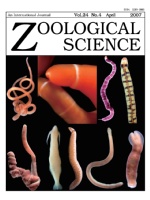 |
-
Vol. 24,
No. 4
- Nemerteans from various localities in Japanese waters. Top left, Cephalothrix sp. (Palaeonemertea: Cephalotrichidae). Top second from left, Tubulanus ezoensis Yamaoka, 1940 (Palaeonemertea: Tubulanidae). Top second from right, Micrura bella (Stimpson, 1857) (Pilidiophora: Lineidae). Top right, Lineus mcintoshi sensu Takakura (1898) (Pilidiophora: Lineidae). Bottom left, Baseodiscus curtus (Hubrecht, 1879) (Pilidiophora: Valenciniidae). Bottom second from left, Nectonemertes japonica Foshay, 1912 (Hoplonemertea: Polystilifera: Pelagica). Bottom center, an undescribed species (Hoplonemertea: Polystilifera: Reptantia). Bottom second from right, Amphiporus antifuscus Iwata, 1954 (Hoplonemertea: Monostilifera: Amphiporidae). Bottom right, Malacobdella japonica Takakura, 1897 (Hoplonemertea: Monostilifera: Malacobdellidae). In the corresponding article in this issue, H. Kajihara provides a taxonomic checklist of all nemertean species reported from Japan, including synonymies and comments on taxonomical problems.
Related Article
|















































































































































